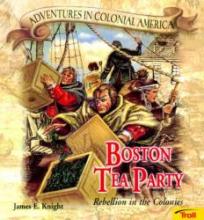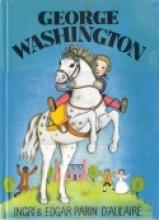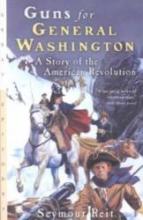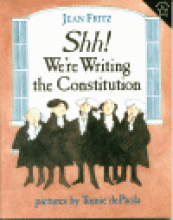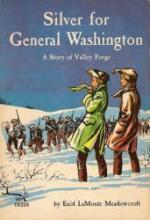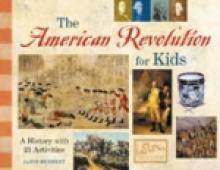History American Revolution Era
And Then What Happened, Paul Revere?
Number of pages:
64 pages
Copyright:
1973
Publisher:
Scholastic
Binding:
Softcover
Subject(s):
Setting:
Grade / Age level:
Review:
This is a humorous yet informative account of Paul Revere's famous ride to alert the countryside that "the Redcoats" were coming. The details are quite interesting and carefully researched (down to a few details that Paul Revere liked to include when telling the story to his own grandchildren). There are a few slightly annoying details in the illustrations, but I wouldn't consider them serious (e.g. a picture of a Boston scene that includes a picture of a pirate's head - not detailed enough to be gory, but a bit gross) . Fully illustrated (not fabulous illustrations, but they suffice) and appropriate for early grade school.
Reviewed by:
First reviewed:
9-13-2000
Boston Tea Party
Rebellion in the Colonies
Subject(s):
Setting:
Grade / Age level:
Review:
One of the most famous events leading up to the American Revolution is often not well-understood. Even many history textbooks muddle or even mutilate the facts causing many people to think that those who dumped tea into Boston Harbor on that December night in 1773 were basically looting the ships because they were upset about taxes. The truth is more subtle and a lot more respectable than that and this is a fine book (with lovely pen and ink illustrations) to clear up all the confusion. From the "Adventures in Colonial America" series. 3rd grade and up.
Reviewed by:
First reviewed:
6-5-02
George Washington
Subject(s):
Setting:
Grade / Age level:
Review:
It is just like the D'Aulaire's to create a story (complete with beautiful full-color illustrations) that would be interesting and appealing to small children and yet teach more about the character and upbringing of "the Father of Our Country" than most textbooks. The story covers our First President's early childhood - growing up in Colonial America - his adventures (and character) as a young officer during the French and Indian War and, of course, his role in the American Revolution and as president.
Reviewed by:
First reviewed:
1998-99
Guns for General Washington. A Story of the American Revolution
Subject(s):
Setting:
Grade / Age level:
Review:
The future looks dim for the Continental army. With scare firewood, little needed supplies of food, blankets and muskets, meager shelter, and disorganized soldiers deserting, the prospects of winning the war, let alone recapturing Boston look doubtful.
To compound the problem, their munitions supply is dwindling fast and they have no heavy artillery to defend themselves or create an offensive attack.
Aboard the HMS Somerset General Howe, the commander of the British army, is anxiously awaiting reinforcements.
But Col. Henry Knox is not one to sit idle and wait. He comes up with a clever plan to bring 183 cannons from Fort Ticonderoga back to Boston. This is no small task and even though everyone else believes it will end in failure Gen. Washington gives his approval of the daring plan.
Fighting against insurmountable odds, sheer cliffs, blinding snowstorms, melting rivers, and more, Col. Knox, along with his younger brother and a brave band of men, seek to defy all odds and using ingenuity, cooperation and perseverance hope to bring the cannons to Boston before the British reinforcements arrive.
Will they make it? Even more important, will they make it before the British crush the meager Continental army?
Not just another historical fiction book about the American Revolution. This book is based on real people and actual events. Following the events with great accuracy, Guns for General Washington offers a gripping account of the incredible dangers they must fact and their ingenuity in overcoming them. This story is a testament to the many virtues of the human spirit.
Reviewed by:
First reviewed:
2-18-2008
John Treegate's Musket
Subject(s):
Setting:
Grade / Age level:
Review:
Reviewed by:
First reviewed:
11-4-2007
My Brother Sam is Dead
Number of pages:
215 pages
Copyright:
1975
Publisher:
Scholastic and others
Binding:
Softcover
Subject(s):
Setting:
Review:
My Brother Sam is Dead is the story of a boy whose brother rebels against his father to join the colonial army in the Revolutionary War. There are many good things to recommend about this story and some warnings to give also.
The boy, Tim Meeker, is witness to the chaotic events of the war. The book gives a good description of the confusion of the times with occupying armies and defiant citizens, senseless death and seemingly cruel punishments. Tim's brother, Sam, joins the patriot army against his father's wishes and even returns to steal his father's gun. Sam's father is a staunch loyalist and scandalized by his son's behavior. The father has also had a taste of war in the French and Indian war and does not want his son to have to experience the horror of it. The son thinks he knows better.
As the war progresses, and goods become scarce, armies on both sides resort to commandeering or stealing for food and supplies. Tim's father is arrested as he is bringing a load of supplies to the tavern he runs and Sam is arrested for stealing cows, which he did not steal. Tim's father dies on a British prison ship and Sam is executed by his own army for theft. The scene of the execution is somewhat unsettling as are other scenes like it in the book.
This is definitely an anti-war story. The authors end the book by asking if we might have been able to accomplish independence without a war. Throughout the story the atrocities of war are reflected upon by Tim and there are many quotes by Tim's father about the price of war, such as, "In war, the dead pay the debts of the living." This slant by the author would make a great subject for discussion.
Another very interesting aspect of story is that the rebellion of the son to his father directly parallels the rebellion of the colonies to the father country, England. The exchanges between father and son could be laid right across the colonies and England. Yet another interesting aspect is the irony of the deaths of father and son. Father, as a loyalist, dies in a prison ship as a prisoner of the country he professes and Sam, as a rebel, dies at the end of an firing squad of his fellow patriots. All of these make this book a great vehicle for discussion of author's bias and purpose, of literary devices such as irony and story structure, and finally of the ideas behind the war itself.
However, there is one great drawback to the story. There is an enormous amount of swearing in it, including taking the Lord's name. If it were just once or twice, you might be able to overlook it, but one teacher I know counted and found over fifty instances of swearing. If you want your children to have the experience of the book, you might consider reading it aloud and editing out the swearing as you read. However, there are many other books available which discuss the ideas of the Revolutionary War while avoiding this drawback.
The boy, Tim Meeker, is witness to the chaotic events of the war. The book gives a good description of the confusion of the times with occupying armies and defiant citizens, senseless death and seemingly cruel punishments. Tim's brother, Sam, joins the patriot army against his father's wishes and even returns to steal his father's gun. Sam's father is a staunch loyalist and scandalized by his son's behavior. The father has also had a taste of war in the French and Indian war and does not want his son to have to experience the horror of it. The son thinks he knows better.
As the war progresses, and goods become scarce, armies on both sides resort to commandeering or stealing for food and supplies. Tim's father is arrested as he is bringing a load of supplies to the tavern he runs and Sam is arrested for stealing cows, which he did not steal. Tim's father dies on a British prison ship and Sam is executed by his own army for theft. The scene of the execution is somewhat unsettling as are other scenes like it in the book.
This is definitely an anti-war story. The authors end the book by asking if we might have been able to accomplish independence without a war. Throughout the story the atrocities of war are reflected upon by Tim and there are many quotes by Tim's father about the price of war, such as, "In war, the dead pay the debts of the living." This slant by the author would make a great subject for discussion.
Another very interesting aspect of story is that the rebellion of the son to his father directly parallels the rebellion of the colonies to the father country, England. The exchanges between father and son could be laid right across the colonies and England. Yet another interesting aspect is the irony of the deaths of father and son. Father, as a loyalist, dies in a prison ship as a prisoner of the country he professes and Sam, as a rebel, dies at the end of an firing squad of his fellow patriots. All of these make this book a great vehicle for discussion of author's bias and purpose, of literary devices such as irony and story structure, and finally of the ideas behind the war itself.
However, there is one great drawback to the story. There is an enormous amount of swearing in it, including taking the Lord's name. If it were just once or twice, you might be able to overlook it, but one teacher I know counted and found over fifty instances of swearing. If you want your children to have the experience of the book, you might consider reading it aloud and editing out the swearing as you read. However, there are many other books available which discuss the ideas of the Revolutionary War while avoiding this drawback.
Additional notes:
Newbery Honor Book
Reviewed by:
First reviewed:
1998-99
Shh! We're Writing the Constitution
Subject(s):
Setting:
Grade / Age level:
Review:
A surprisingly in-depth account of the characters involved in the writing of the United States' Constitution and many of the fascinating details of life at that time, the struggles involved in such a monumental task, and the somewhat humorous attitudes and actions of our Founding Fathers. Approximately 4th grade reading level, but could be read aloud to younger children (and would be informative for older ones as well).
Reviewed by:
First reviewed:
9-13-2000
Silver for General Washington
A Story of Valley Forge
Subject(s):
Setting:
Grade / Age level:
Review:
Silver for General Washington is an engrossing story about twelve-year-old Gil and his sister, Jen, who are living in Valley Forge with their cousins during the occupation of Philadelphia. Before leaving their well-to-do home in Philadelphia, Gil helped his father bury all the family silver in a chest beneath the house. As the winter progresses and conditions grow worse for the poor soldiers, Gil overhears people saying that what's really needed is money to get food and other supplies. Knowing that it's what his father would want (his father is away on war business) Gil decides to sneak back into Philadelphia to recover the silver himself and offer it to General Washington. A nice story that brings to life the struggles and courage present in a critical and difficult time in our country's history that is all too often taken for granted.
Suitable for a family read-aloud or independent reading grades three and up.
Suitable for a family read-aloud or independent reading grades three and up.
Reviewed by:
First reviewed:
6-11-02
The American Revolution for Kids, A History with 21 Activities
Subject(s):
Setting:
Review:
Additional notes:
Sepia and black and white illustrations
Reviewed by:
First reviewed:
1-31-05

